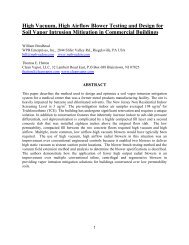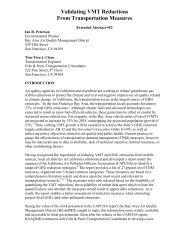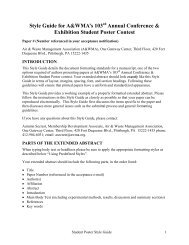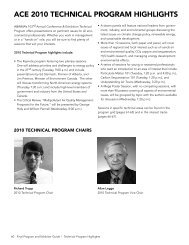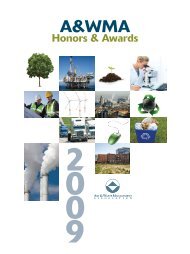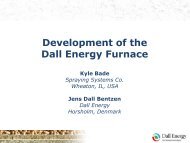Abstract Book
Abstract Book
Abstract Book
Create successful ePaper yourself
Turn your PDF publications into a flip-book with our unique Google optimized e-Paper software.
The Pearl River Delta (PRD) region including Hong Kong Special Administration<br />
Region (HKSAR) located in Southern China covering an area of fast economic growth<br />
with more than 60 million populations providing the work force for the manufacturing<br />
industries and economic activities in the region. The fast economic growth and the rapid<br />
industrialization have contributed to the deterioration of air quality causing frequent acid<br />
rain occurrences and haze days in the PRD region. In recent year, great efforts have been<br />
made by central and regional governments to control air pollution emission.<br />
Power plant has been identified as one of the major industrial air pollution sources and<br />
this paper introduces the emission control technologies commonly applied for power<br />
plant under different installed capacity and fuel type for coal or heavy oil-fired power<br />
plant. Different air pollution control technologies for the removal of sulphur dioxide,<br />
nitrogen oxides and particulate will be discussed in terms of technological, availability,<br />
applicability, operation and maintenance issues. Reference will be made to the recently<br />
published Mid-term Review of Pearl River Delta (PRD) Regional Air Quality<br />
Management Plan and National Technical Guidelines for the control of emissions from<br />
power plant. This paper also discusses the approach adopted by the HKSAR Government<br />
in controlling air emissions from the power stations and the lessons learnt from the<br />
emission control strategies and the way forward for the PRD region.<br />
A Cost-effective Advanced Monitoring Solution - Deployment Of Predictive<br />
Emissions Monitoring System As Compliance Solution For Gas Turbine And Boiler<br />
Applications In The United States (129)<br />
B. G. Swanson, 1 T. K. Eisenmann 2 ; 1 CMC Solutions LLC, Wixom, MI, 2 CMC Solutions<br />
LLC, Munich, Germany<br />
Sources required to continuously monitor emissions for compliance determination may<br />
elect to use alternatives to continuous emissions monitoring systems (CEMS) in the<br />
United States. These alternatives include parametric and predictive emissions monitoring<br />
systems (PEMS). The alternative methods for compliance determination available on the<br />
market today are to be discussed. The requirements for such alternative monitoring<br />
systems including performance specification testing required under 40 CFR Part 60 (PS<br />
16) and 40 CFR Part 75 (Subpart E) are highlighted.<br />
Predictive emission monitoring solutions have been deployed for NOx, SO2 and CO<br />
compliance under applicable regulations for gas turbines and boilers in utility,<br />
petrochemical, ethanol, steel, and other industrial and municipal applications. Certified<br />
PEMS have allowed plants to replace CEMS on boiler and gas turbine exhaust stacks<br />
resulting in a greater than 50% reduction in ongoing operational costs of compliance<br />
monitoring programs. This paper is detailing the differences of existing PEMS solutions.<br />
Results of certification and the costs associated with the installation and ongoing<br />
operation of PEMS in lieu of CEMS with gas analyzers are demonstrated with examples<br />
of a U.S. cogeneration facility. In addition, PEMS quality assurance including relative<br />
accuracy test audits (RATA) is outlined and evaluated. Not least, other regulatory<br />
requirements and methods used for international applications are also reviewed and an<br />
overview of activities to use PEMS outside the United States shall be given.<br />
44




